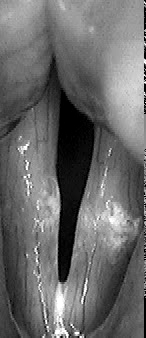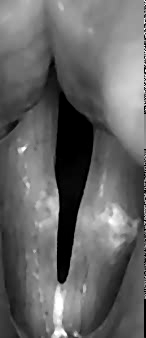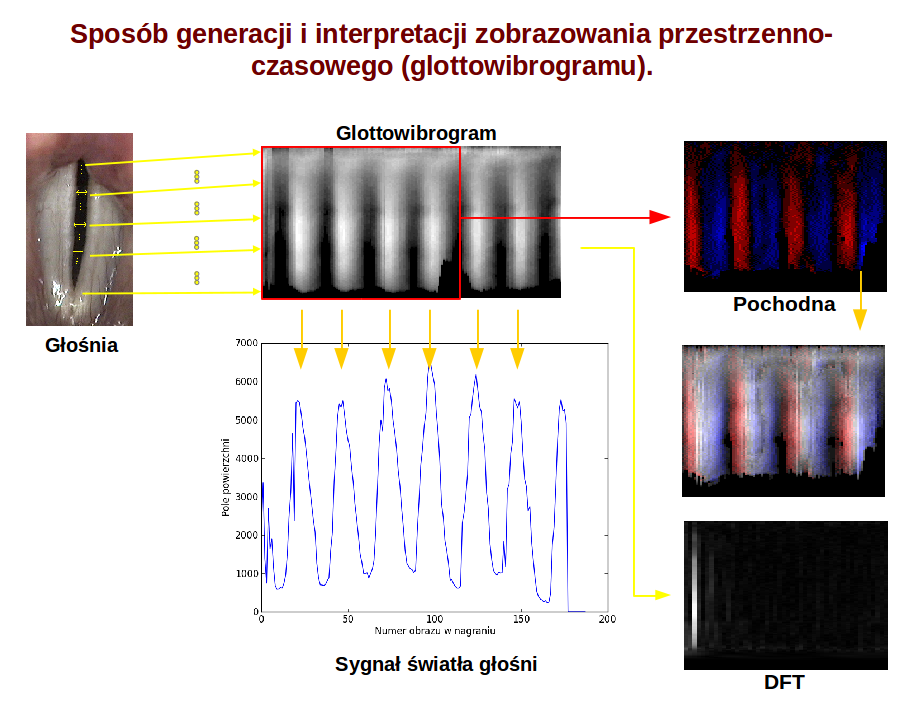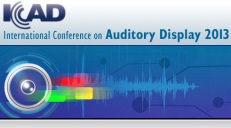Bartosz Kopczyński M.Sc.
Supervisor: Prof. Paweł Strumiłło Dr. Hab.
Research: Algorithms for computer based analysis of laryngovideostroboscopic images for supporting the objective diagnosis of disorders of the vocal fold's phonatory function
uantitative assessment of videolaryngostroboscopic images in patients with glottic pathologies
Introduction. Digital imaging techniques enable exploration of novel visualisation modalities of the vocal folds during phonation and definition of parameters facilitating more precise diagnosis of voice disorders.
Aim. Application of computer vision algorithms for analysis of videolaryngostroboscopic (VLS) images aimed at qualitative and quantitative description of phonatory vibrations.
Materials and methods. VLS examinations were conducted for subjects with vocal nodules, subjects with glottal incompetence and normophonic females. The recorded VLS images were pre-processed, the glottis area was segmented out and the glottal cycles were identified. The glottovibrograms were built and then the glottal area waveforms (GAW) were quantitatively described by computing the following parameters: Open Quotient (OQ), Closing Quotient (CQ), Speed Quotient (SQ), Minimal Relative Glottal Area (MRGA), and a new parameter termed Closure Difference Index (CDI).
Results. Profiles of the glottal widths assessed along the glottal length differentiated the study groups (p<0.001). Moreover, it was shown that the OQ, CQ, CDI and MRGA indices can be considered as viable parameters for quantifying kinematics of the vocal folds for normophonic subjects and patients with diagnosed vocal nodules and glottal incompetence (p<0001).
Research is conducted in collaboration with prof. med. Ewa Niebudek-Bogusz from the Department of Audiology and Phoniatrics of the Nofer Institute of Occupational Medicine in Lodz.

![]()

![]()


This work was supported by the National Science Centre, Poland, grant PRELUDIUM no. UMO-2016/21/N/ST6/02612 in years 2017-2019.
Publications:
- B. Kopczynski, P. Strumillo, M. Just and E. Niebudek-Bogusz, "Acoustic Based Method for Automatic Segmentation of Images of Objects in Periodic Motion: detection of vocal folds edges case study," 2018 Eighth International Conference on Image Processing Theory, Tools and Applications (IPTA), Xi'an, 2018, pp. 1-6. doi: 10.1109/IPTA.2018.8608152.
- B. Kopczyński, P. Strumiłło, M. Just, E. Niebudek-Bogusz “Generating 3D spatio-temporal models of vocal folds vibrations from high speed digital imaging” International Symposium on Biomedical Imaging (ISBI), Washington, DC, pp. 612-615, 2018, doi: 10.1109/ISBI.2018.8363650.
- B. Kopczyński, P. Strumiłło, E. Niebudek-Bogusz “Glottocorrelographic Visualization of Normal and Pathological Vocal Folds Oscillations from Videolaryngostroboscopic Images” Polish Conference on Biocybernetics and Biomedical Engineering, Advances in Intelligent Systems and Computing, 2018, ISBN 978-3-319-66904-5, doi: 10.1007/978-3-319-66905-2_17.
- E. Niebudek-Bogusz, B. Kopczynski, P. Strumillo, J. Morawska, J. Wiktorowicz J. & M. Sliwinska-Kowalska (2016): "Quantitative assessment of videolaryngostroboscopic images in patients with glottic pathologies", Logopedics Phoniatrics Vocology, doi: 10.3109/14015439.2016.1174293 (IF=0.932).
- B. Kopczyński, P. Strumiłło, E. Niebudek-Bogusz. "Computer based quantification of normal and pathological vocal folds phonatory processes from laryngovideostroboscopy".
Federated Conference on Computer Science and Information Systems (IEEE Xplore Digital Library). https://fedcsis.org/proceedings/2015/drp/276.html - B. Kopczyński, P. Strumiłło, E. Niebudek-Bogusz, "Ocena funkcji fonacyjnej krtani z zastosowaniem komputerowej analizy obrazów laryngowideostroboskopowych – badania pilotażowe", Otorynolaryngologia 2014, 14(3) 147+154.





